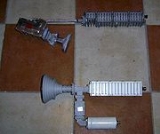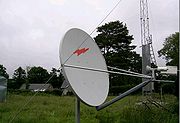
Block upconverter
Encyclopedia


Transmission (telecommunications)
Transmission, in telecommunications, is the process of sending, propagating and receiving an analogue or digital information signal over a physical point-to-point or point-to-multipoint transmission medium, either wired, optical fiber or wireless...
(uplink
Uplink
A telecommunications link is generally one of several types of information transmission paths such as those provided by communication satellites to connect two points on earth.-Uplink:...
) of satellite
Satellite
In the context of spaceflight, a satellite is an object which has been placed into orbit by human endeavour. Such objects are sometimes called artificial satellites to distinguish them from natural satellites such as the Moon....
signals. It converts a band (or "block") of frequencies from a lower frequency to a higher frequency. Modern BUCs convert from the L band
L band
L band refers to four different bands of the electromagnetic spectrum: 40 to 60 GHz , 1 to 2 GHz , 1565 nm to 1625 nm , and around 3.5 micrometres .-NATO L band:...
to Ku band
Ku band
The Kμ band is a portion of the electromagnetic spectrum in the microwave range of frequencies. This symbol refers to —in other words, the band directly below the K-band...
, C band
C band
The C band is a name given to certain portions of the electromagnetic spectrum, including wavelengths of microwaves that are used for long-distance radio telecommunications. The IEEE C-band - and its slight variations - contains frequency ranges that are used for many satellite communications...
and Ka band
Ka band
The Ka band covers the frequencies of 26.5–40 GHz. The Ka band is part of the K band of the microwave band of the electromagnetic spectrum. This symbol refers to "K-above" — in other words, the band directly above the K-band...
. Older BUCs convert from a 70 MHz intermediate frequency (IF) to Ku band or C band.
Most BUCs use phase-locked loop
Phase-locked loop
A phase-locked loop or phase lock loop is a control system that generates an output signal whose phase is related to the phase of an input "reference" signal. It is an electronic circuit consisting of a variable frequency oscillator and a phase detector...
local oscillator
Electronic oscillator
An electronic oscillator is an electronic circuit that produces a repetitive electronic signal, often a sine wave or a square wave. They are widely used in innumerable electronic devices...
s and require an external 10 MHz frequency reference to maintain the correct transmit frequency.
BUCs used in remote locations are often 2 or 4 W
Watt
The watt is a derived unit of power in the International System of Units , named after the Scottish engineer James Watt . The unit, defined as one joule per second, measures the rate of energy conversion.-Definition:...
in the Ku band
Ku band
The Kμ band is a portion of the electromagnetic spectrum in the microwave range of frequencies. This symbol refers to —in other words, the band directly below the K-band...
and 5 W in the C band
C band
The C band is a name given to certain portions of the electromagnetic spectrum, including wavelengths of microwaves that are used for long-distance radio telecommunications. The IEEE C-band - and its slight variations - contains frequency ranges that are used for many satellite communications...
. The 10 MHz reference frequency is usually sent on the same feedline as the main carrier
Carrier wave
In telecommunications, a carrier wave or carrier is a waveform that is modulated with an input signal for the purpose of conveying information. This carrier wave is usually a much higher frequency than the input signal...
. Many smaller BUCs also get their direct current
Direct current
Direct current is the unidirectional flow of electric charge. Direct current is produced by such sources as batteries, thermocouples, solar cells, and commutator-type electric machines of the dynamo type. Direct current may flow in a conductor such as a wire, but can also flow through...
(DC) over the feedline, using an internal DC block.
BUCs are generally used in conjunction with low-noise block converter
Low-noise block converter
A low-noise block downconverter is the receiving device of a parabolic satellite dish antenna of the type commonly used for satellite TV reception...
s (LNB). The BUC, being an up-converting device, makes up the "transmit" side of the system, while the LNB is the down-converting device and makes up the "receive" side. An example of a system utilizing both a BUC and an LNB is a VSAT
Very small aperture terminal
A very-small-aperture terminal , is a two-way satellite ground station or a stabilized maritime Vsat antenna with a dish antenna that is smaller than 3 meters. The majority of VSAT antennas range from 75 cm to 1.2 m. Data rates typically range from 56 kbps up to 4 Mbps...
system, used for bidirectional
Duplex (telecommunications)
A duplex communication system is a system composed of two connected parties or devices that can communicate with one another in both directions. The term multiplexing is used when describing communication between more than two parties or devices....
Internet
Internet
The Internet is a global system of interconnected computer networks that use the standard Internet protocol suite to serve billions of users worldwide...
access via satellite.
The block upconverter is assembled with the LNB in association with an OMT, orthogonal mode transducer
Orthomode transducer
An orthomode transducer is a microwave duct component of the class of microwave circulators. It is commonly referred to as an OMT, and commonly referred as a polarisation duplexer. Such device may be part of a VSAT antenna feed Orthomode transducers serve either to combine or to separate two...
to the feed-horn that faces the reflector parabolic dish.

